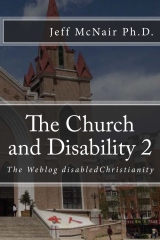When experts in disability studies discuss disability as a concept, they will at times discuss various models. Minimally there will be three; the medical model, the moral model and the social model. In both the medical and moral models, disability is totally focussed on the individual. The medical model largely sees someone with an impairment as someone to be healed or corrected. You own your impairment and my interactions with you are geared toward addressing your problem. The moral model says that your impairment is due to something that you or your family or parents did. You are to blame for this thing called impairment that has happened in your life.
If we believe either of these models are the reality, it will cause us to do things in relation to people with impairments in particular ways. Chances are, one aspect of treatment will be segregation. As a student of mine, Sarah Slayman, once wrote in a paper, "Segregation centers disability within the individual." If I follow one of these two models (medical, moral) I feel limited responsibility toward the person with the impairment, other than perhaps, some sort of therapeutic or rehabilitation based interactions. Your life experience with an impairment has nothing to do with me. So I even perceive my segregation of you, on the basis of your impairment, is based on something about you not something about me.
The model that emerged in reaction to the medical and moral models was the social model which takes the perspective that disability is not due to impairment but is entirely based in society. Disability is actually the result of societal response to impairment. It is not difficult to make the connection between how those with some form of impairment might feel in reaction to the medical or moral models and the treatment that followed and the reaction of saying that the entire experience of disability is caused by the environment.
The connection between these ideas and the church is that if I segregate persons with disabilities, I am once again, centering disability within the individual. I create a somewhat new class of people called people with an impairment, who are a culture to themselves. If they are a culture to themselves, it is because the larger culture(s) have isolated them to the point that they find themselves together in an isolated group. I may find myself as a member of a culture of excluded people, my characteristic being society's reaction to my impairment." This experience, particularly from a Christian perspective, should not be sufficient to isolate me. Culture by exclusion is not something to be celebrated. I make you become your own culture by distancing you from myself. The excluded culture's characteristic being something imposed upon them by the dominant culture in more of a moral model kind of way in response to a personal characteristic. If we then celebrate the excluded group by providing ministry to them on the basis of their "culture" we support the devaluation and segregation by society. In order to fight culture by exclusion, we must instead refuse to recognize the culture by exclusion and instead insist that we are one in Christ.
We therefore need to be exceedingly careful if we are involved in any activity that segregates people on the basis of any characteristic. When we do so, we are saying that a person's characteristic and their life experience as a result of that characteristic totally resides within them and that we agree with society's way of interacting with them and isolation of them.
McNair
If we believe either of these models are the reality, it will cause us to do things in relation to people with impairments in particular ways. Chances are, one aspect of treatment will be segregation. As a student of mine, Sarah Slayman, once wrote in a paper, "Segregation centers disability within the individual." If I follow one of these two models (medical, moral) I feel limited responsibility toward the person with the impairment, other than perhaps, some sort of therapeutic or rehabilitation based interactions. Your life experience with an impairment has nothing to do with me. So I even perceive my segregation of you, on the basis of your impairment, is based on something about you not something about me.
The model that emerged in reaction to the medical and moral models was the social model which takes the perspective that disability is not due to impairment but is entirely based in society. Disability is actually the result of societal response to impairment. It is not difficult to make the connection between how those with some form of impairment might feel in reaction to the medical or moral models and the treatment that followed and the reaction of saying that the entire experience of disability is caused by the environment.
The connection between these ideas and the church is that if I segregate persons with disabilities, I am once again, centering disability within the individual. I create a somewhat new class of people called people with an impairment, who are a culture to themselves. If they are a culture to themselves, it is because the larger culture(s) have isolated them to the point that they find themselves together in an isolated group. I may find myself as a member of a culture of excluded people, my characteristic being society's reaction to my impairment." This experience, particularly from a Christian perspective, should not be sufficient to isolate me. Culture by exclusion is not something to be celebrated. I make you become your own culture by distancing you from myself. The excluded culture's characteristic being something imposed upon them by the dominant culture in more of a moral model kind of way in response to a personal characteristic. If we then celebrate the excluded group by providing ministry to them on the basis of their "culture" we support the devaluation and segregation by society. In order to fight culture by exclusion, we must instead refuse to recognize the culture by exclusion and instead insist that we are one in Christ.
We therefore need to be exceedingly careful if we are involved in any activity that segregates people on the basis of any characteristic. When we do so, we are saying that a person's characteristic and their life experience as a result of that characteristic totally resides within them and that we agree with society's way of interacting with them and isolation of them.
McNair










